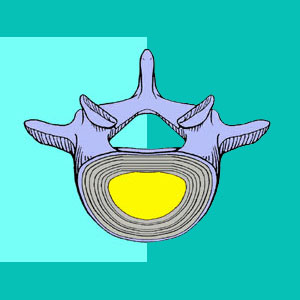
Intervertebral discs, also called spinal discs or simply discs, are an important component of the human spine. There are 23 discs in the typical human spinal column and the combined height of these discs accounts for 25% of the total length of the backbone.
This vital resource section will detail the physical characteristics of intervertebral spinal discs and their functional importance to the anatomy of the spine. We will also explore how time and injury can change the structure of the intervertebral tissues.
Structure of Intervertebral Discs
The anatomy of a disc changes throughout its lifecycle, mostly due to completely normal spinal degenerative processes. Discs are composed of collagen and proteoglycans, along with a high percentage of water, which is stored in the soft center of the structure. This pliable moisture rich core is called the nucleus pulposus. The nucleus is surrounded by a multi-layered woven outer wall called the annulus fibrosus. This tough outer wall protects the nucleus and provides structure and stability for the soft disc core.
Neuroforamen are the crucial openings that allow the spinal nerves to exit the central canal space.
Learn all about intervertebral disc anatomy, also known as spinal disc anatomy.
Herniated disc photos visualize how intervertebral pathologies look inside the spinal canal.
Aging can cause spinal discs to calcify and fuse to the vertebral bones above and/or below. This is the cause of osteochondral bars in the spine.
Spinal Discs and Aging
Degeneration is the term used to describe the aging processes which affect all spinal discs. These processes are completely normal, expected and universal, although the exact extent of disc degeneration is a highly individual criterion.
As we age, spinal discs dry out, losing their ability to retain moisture. This makes them shrink in size and mass, creating what the medical community has termed degenerative disc disease. This process is not a disease at all and rarely causes any problems for affected patients. However, the condition has been vilified in the back pain industry and often acts as a scapegoat condition to take the blame for otherwise idiopathic symptoms.
Facts about Intervertebral Discs
Most people experience significant age and activity-related degeneration in their lumbar and cervical spinal discs by the age of 30. Some individuals might demonstrate these changes much earlier. The first discs to wear out are typically the L4/L5 and the L5/S1 lumbar discs.
Discs can herniate or rupture spontaneously, due to injury, or slowly, due to degeneration. Herniated disc injuries are sometimes painful, but should heal in a matter of 2 to 8 weeks, even with no formal treatment. Herniated discs due to degeneration are typically not symptomatic and might not even be discovered for many years. Disc degeneration increases the chances for experiencing a herniation, but decreases the chances for a symptomatic event.
Spinal discs have no internal nerve or blood supply. Unless a disc pathology compromises a nearby nerve structure, the herniation will be completely unable to cause any pain whatsoever. When herniated discs compromise the function of a spinal nerve or the spinal cord, then symptoms are possible and might become major chronic pain concerns.




